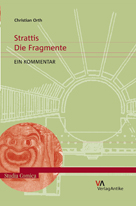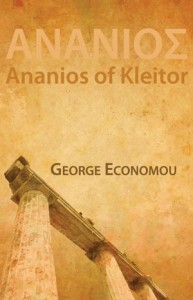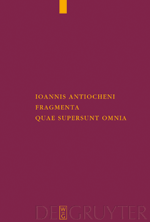Here is the first complete commentary to the 91 fragments of the Attic comic poet Strattis (ca. 410-380 BC):
Monica Berti on December 28 2009
Cambridge Centre for Material Texts
The Cambridge Centre for Material Texts presents its “new forum for the study of the word in the world”.
This is a pilot website that aims at “pushing forward critical, theoretical, editorial and bibliographical work in an area which is galvanizing humanities scholarship. Addressing a huge range of textual phenomena and traversing disciplinary boundaries that are rarely breached by day-to-day teaching and research, the Centre will foster the development of new perspectives, practices and technologies, which will transform our understanding of the way that texts of many kinds have been embodied and circulated”.
This initiative addresses two questions: 1) what is a material text?; 2) in which way do materials, tools, media, and wordly circumstances affect the production and the dissemination of a text?
Both questions are fundamental when collecting and editing fragmentary texts.
Monica Berti on December 16 2009
Ananios of Kleitor
On the Papy-list Traianos Gagos announces the publication of the fragments of an almost unknown Greek poet named Ananios of Kleitor:
Ananios was born in 399 BC in the Arcadian city of Kleitor. His work is known through forty-one fragmentary poems preserved on papyrus fragments, along with twenty-five passages of verse attributed to him in quotations cited in various commentaries and literary works from the 2nd century BC to the 11th century AD.
Read the review by Tim Whitmarsh from The Times Literary Supplement.
Monica Berti on December 15 2009
DAI – FGrHist V
The German Archaeological Institute (DAI) is sponsoring the edition, translation, and commentary of the ancient geographers’ fragments originally planned by Felix Jacoby for the fifth volume of the Fragmente der Griechischen Historiker.
The project FGrHist V is directed by Hans-Joachim Gehrke and coordinated by Veronica Bucciantini.
This project involves a large international team of editors. The fragments will be edited, commented, and translated into German, English, French, Italian and Spanish, according to the different editing scholars.
The edition will be published by Brill and is part of the big international project known as the continuation of Jacoby’s FGrHist.
Monica Berti on December 7 2009
Fragmentary texts and digital libraries
I post a document with some notes on the main characteristics of fragmentary texts to be represented in a digital library of classical sources:
Monica Berti on December 7 2009
Ioannis Antiocheni fragmenta
Reviewed by Mark Whittow on BMCR 2009.12.06
Cf. also BMCR 2006.07.37 on Roberto Umberto (ed.). Ioannis Antiocheni Fragmenta ex Historia chronica. Introduzione, edizione critica e traduzione. Texte und Untersuchungen zur Geschichte der altchristlichen Literatur, 154. Berlin: Walter de Gruyter, 2005. Pp. ccxi, 661. ISBN 3-11-018687-X. €178.00
Monica Berti on December 2 2009
The edition of fragmentary texts: scattered remarks
Virgilio Costa sends us a document on the practice of editing and commenting fragments of ancient Greek historians:
In this document he reflects on the fundamental duties of an editor when working with fragmentary texts.
Virgilio Costa is professor of Greek history at the University of Rome Tor Vergata and editor of a new edition of the fragments of the Atthidographer Philochorus: Filocoro di Atene. I. Testimonianze e frammenti dell’Atthis. Tivoli (Roma): Tored. 2007.
Monica Berti on November 26 2009
Classics & Digital Humanities
Gregory Crane, editor in chief of the Perseus Digital Library, was invited as a Visiting Professor to the University of Rome Tor Vergata on October 20-27, 2009.
On that occasion, he gave three seminars in Italian on the following topics:
- La storia di Perseus Digital Library e la nascita delle Digital Humanities negli Stati Uniti
- Presente e futuro di Perseus Digital Library
- Frontiere delle Digital Humanities in epigrafia e filologia classica
The seminars were followed by two conferences of Monica Berti and Matteo Romanello on:
- Esempi di marcatura dei frammenti nei Deipnosofisti di Ateneo
- Le tecnologie digitali e l’epigrafia: esempi applicativi
See the Program



